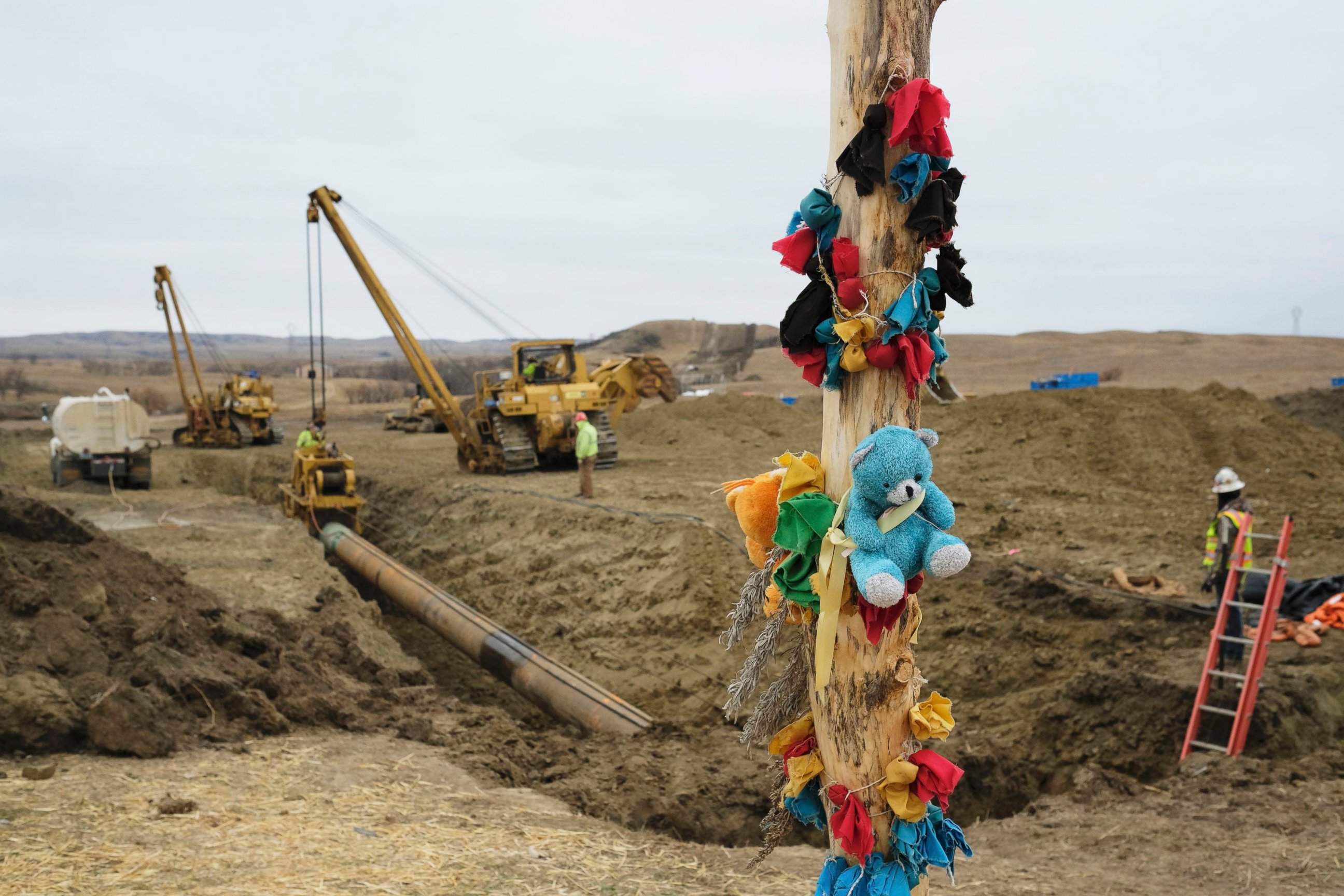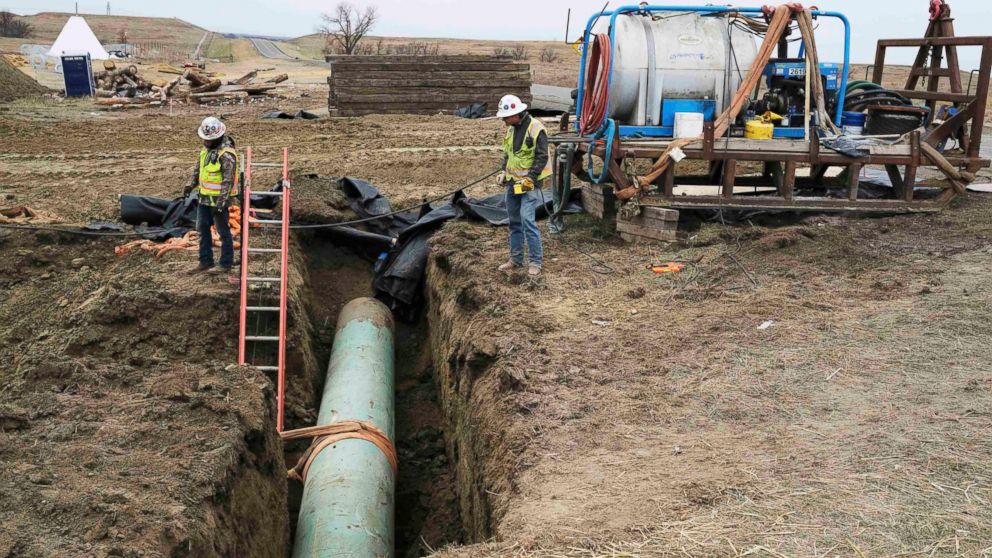Why a Previously Proposed Route for the Dakota Access Pipeline Was Rejected
— -- President Obama said in an interview published this week that the U.S. Army Corps of Engineers was considering rerouting the Dakota Access Pipeline to accommodate the "sacred lands of Native Americans," sparking speculation over the fate of the controversial crude oil pipeline.
But it also prompted some to point out that the current path of the pipeline is actually a reroute itself, with critics calling this reroute an act of "environmental racism."
A previously proposed route for the 1,172-mile pipeline had it crossing the Missouri River north of Bismarck, North Dakota, according to a document filed as part of the permitting process. The eventual route that was decided on, and is currently in construction, moved the water crossing of the crude oil pipeline south of the North Dakota capital, to just upstream of the Standing Rock Sioux tribe's reservation.
“This pipeline was rerouted towards our tribal nations when other citizens of North Dakota rightfully rejected it in the interests of protecting their communities and water. We seek the same consideration as those citizens," Dave Archambault II, chairman of the Standing Rock Sioux tribe, said in a statement on Sunday.
"It’s disappointing to see our state and federal officials advance their corporate, pro-Big Oil energy platform here in North Dakota at the expense of human health, safety and tribal sovereignty," Archambault added.
Prominent activist Rev. Jesse Jackson, who joined protesters in North Dakota last week, called the reroute "the ripest case of environmental racism I've seen in a long time."
The North Dakota Public Service Commission (PSC) refuted allegations of environmental racism, saying that the Bismarck route proposal was never submitted to the agency because permits for it were denied by the U.S. Army Corps of Engineers during its environmental assessment.
“The river crossing north of Bismarck was a proposed alternative considered by the [Dakota Access] company early in the routing process. This route was never included in the proposed route submitted to the PSC and therefore was never vetted or considered by us during our permitting process. It had been eliminated by the U.S. Army Corps of Engineers during their environmental assessment," North Dakota Public Service Commission Chair Julie Fedorchak said in statement on Oct. 27.
"The final permitted route follows an existing pipeline corridor that has been previously disturbed,” added Fedorchak, who also serves as the "pipeline siting portfolio holder," that is, the person in charge of permitting the pipeline route.
Gene Pawlik, a spokesman for the U.S. Army Corps of Engineers, told ABC News today that "the Army does not have a set timeframe to complete its ongoing review of previous DAPL permitting decisions. As part of this process, the Army is exploring a range of options that take into account concerns raised by the relevant stakeholders and will decide the best path to move forward."
"We cannot speculate on what the possible outcomes of the review might be," Pawlik added.
In its environmental assessment, the Corps rejected the Bismarck route to protect wells that serve the municipal water supply, according to The Bismarck Tribune. The Bismarck route would also have been more than 10 miles longer and would have made it difficult to meet PSC requirements to keep the pipeline 500 feet or more away from homes, the Tribune reported.
The current route of the pipeline, which the Standing Rock Sioux tribe argues traverses culturally sacred sites and poses a risk to the reservation's water supply, was largely chosen because it runs along existing infrastructure such as railways and other pipelines, Dakota Access argued in its application to the PSC for permits.
"The most significant route revisions occurred early in the routing process and occurred primarily due to attempts to avoid tribal and federally owned lands, minimize environmental impacts, avoid environmentally sensitive areas, and maximize collocation," the company stated in its permit application.

However, President Obama's comments on a possible reroute come at a time when the pipeline is nearing completion, meaning there may be major hurdles to rerouting it now, according to some experts.
"For Dakota Access, time is money," Tyler Priest, a professor at the University of Iowa who served as a senior policy analyst for the President's National Commission on the BP Deepwater Horizon Oil Spill and Offshore Drilling, told ABC News on Monday. "They want to get this done as fast as they can."
"Most of it is already built, so I don't know if it would require pulling up pipeline," Priest said of a potential reroute.
Afolabi Ogunnaike, a senior analyst at the energy consulting firm Wood Mackenzie who specializes in North America's crude oil markets, told ABC News, "one would imagine that a reroute is possible, but I don't know how well that would be received," adding that the pipeline is "approaching 90 percent" completion in areas other than the disputed 20-mile stretch in North Dakota.
The movement to block the pipeline has garnered nationwide support, with hundreds of environmentalists and Native American groups camping out in demonstration near the Standing Rock Sioux tribe's reservation in Cannon Ball, North Dakota. A crowdfunding campaign set up for the protesters recently reached the $1 million mark.
The fate of the controversial pipeline in its current route currently rests with the Army Corps of Engineers, which is reviewing the final easement that Dakota Access needs in order to construct beneath the Missouri River.





